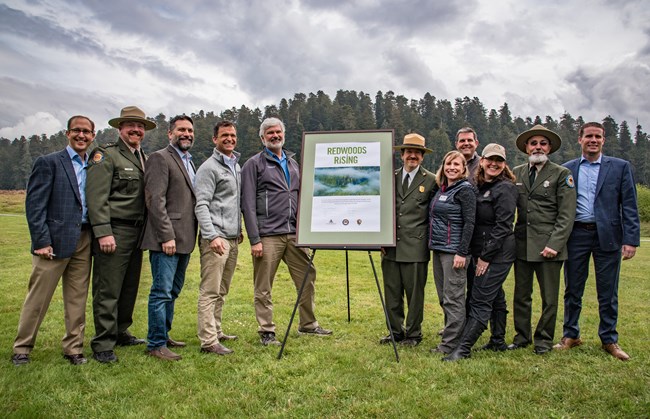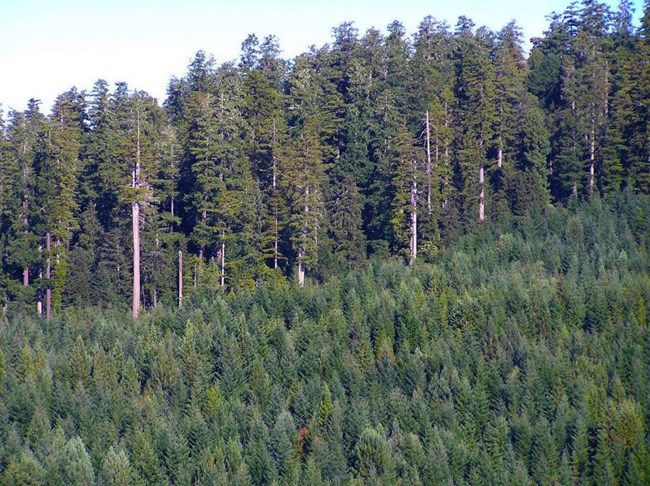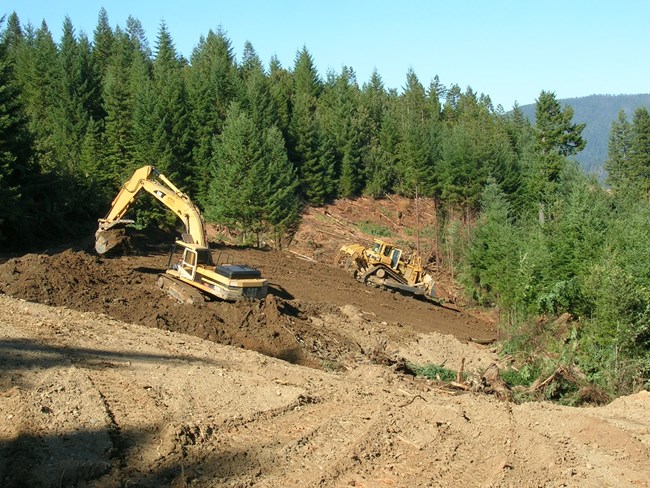
Right: Location of the Greater Prairie Creek (GPC) restoration area. STRL and NPS 
STRL Quick Facts
The mission of Redwoods Rising is to protect old-growth stands, restore redwood forest ecosystems, and ensure the long-term health of these lands. Together with redwood enthusiasts, park visitors, local communities, and tribes, we seek to increase support, knowledge, and appreciation of the iconic and unique California redwood forest landscape. Geographic Area of Redwood National and State Parks ● Collectively: 119,400 acres of forested public lands ● Specifically: ○ 70,300 acres in Redwood National Park
○ 28,100 acres in Del Norte Coast Redwoods State Park ○ 9,700 acres in Jedediah Smith Redwoods State Park ○ 11,300 acres in Prairie Creek Redwoods State Park 
CDPR Partnership Background and NeedWhat is Redwoods Rising? Redwoods Rising is the collaborative initiative of California State Parks (CSP), the National Park Service (NPS), and Save the Redwoods League (League). Together, we will be implementing a landscape-scale restoration program to improve redwood forest health and conditions across 120,000 acres of public lands in Redwood National and State Parks (RNSP). 1. Create a shared restoration strategy

NPS Funding and GovernanceHow is Redwoods Rising funded?The collaborating organizations are providing funds and staff time for surveys, planning, compliance, project management, communication and outreach, and implementation. The League is also committed to leveraging additional public and private support to help increase agency capacity and accelerate the pace of restoration efforts. What is the governance structure? The current structure of Redwoods Rising includes a Leadership Team, Steering Committee, and Technical Advisory Committees. 
CDPR Restoration Goals and Need120,000 acres? Where do you start? Our vision is to restore the over 70,000 acres of degraded redwood ecosystems in the Mill Creek and the Prairie Creek watersheds of Redwood National and State Parks, to remove or restore hundreds of miles of abandoned roads, and to continue to build overall capacity for greater collaboration and enhanced restoration of redwood ecosystems. We are beginning by rehabilitating over 8,000 acres of previously logged forests in the Prairie Creek Watershed and over 25,000 acres in the Mill Creek Watershed. What does Redwoods Rising hope to accomplish in the future? Our (very) long-term goal is to restore forests of giant coast redwoods in all 120,000 acres of Redwood National and State Parks. Why restore the forest? Redwood National and State Parks is home to 45 percent of the remaining protected old-growth redwoods, including some of the tallest trees in the world. However, 80,000 of the 120,000 acres of Redwood National and State Parks' redwood forests were logged before they became part of the parks. Large swaths of too-dense, young forests that have grown up in these areas surrounding the remaining primeval redwood stands. Some of these second-growth forests have grown back on their own, but many are a result of re-seeding or planting by logging companies after they harvested the original old-growth redwoods—often with non-redwood species such as Douglas-fir. Trees in these reseeded areas in particular are unnaturally dense, with as many as 10 times the number of trees per acre as an old-growth forest. These thin trees are desperately competing for space, light, water, and nutrients, crowding each other as well as important understory vegetation. These forests are not healthy and do not provide anywhere near the ecological values of a mature redwood forest. Furthermore, failing and inaccessible old logging roads thread through the landscape, accelerating the spread of invasive species and sending sediment into nearby streams, potentially threatening endangered coho salmon and steelhead trout. Existing culverts and stream crossings installed by the logging companies that have not been maintained are also vulnerable to failure. The goal of Redwoods Rising is to help undo this damage to fast-track the development of healthy redwood forests. What are you restoring? Previously logged second-growth forests are our primary focus. However, Redwoods Rising is also restoring streams and other associated ecosystems that are a part of a healthy landscape. Were all of the logged areas in Redwood National and State Parks totally clear-cut? Although many areas were clear-cut, in some places there are still old-growth trees scattered here and there among second-growth forests. These trees are reservoirs of genetic information and biological richness that can help support forest recovery. They also provide habitat for species that depend on old-growth trees, even within otherwise young stands. These trees also benefit from restoration activities that reduce competition for resources and that allow them room to reproduce through seeds or resprouting. By improving conditions around these residual trees, we in turn enhance their protection and habitat quality as well. What are the characteristics of old-growth redwoods and why are they important? The giant redwood trees of an old-growth forest have intricate canopies that create habitat, store large amounts of carbon and maintain high levels of biodiversity. Some species, such as marbled murrelets and Humboldt martins require old-growth conditions to survive. Less than 5% of the historical range of these forests remains. Some characteristics of old-growth forests include: 1. Big, old trees of varying height, girth, and age
2. Large snags, or standing dead trees that provide habitat for a wealth of wildlife 3. Large fallen trees on the forest floor that decompose slowly over many decades providing homes for many of the smallest dwellers of the forest: insects, spiders, centipedes, and salamanders as well as fungi 4. A multilayered and continuous canopy with spatial variability, where younger trees and understory plants find space in the gaps between larger trees 5. Trees with large branches and deep crowns Won’t nature heal itself if given enough time? Such significant damage was done to the landscape by logging—and the associated roads, culverts and stream crossings—that in many cases natural processes like hydrology, erosion, and plant regrowth no longer function the way they would need in order for the system to recover on its own in the foreseeable future. If left alone, these ecosystems would likely continue to deteriorate for a long time before they could even begin to recover—putting the plant and animal species that depend upon them at great risk. Furthermore, fierce competition for light among second-growth trees has led to stands of tall, skinny trees of similar age that are vulnerable to being easily knocked down by wind, rain, or snow or infected by pests and disease. Where that occurs, many trees can be lost at once as they are all similarly vulnerable, setting decades of forest regrowth back to the starting point. In some cases, non-redwood tree species such as Douglas-fir and even exotic tree species were planted or aerially seeded following logging operations, further altering forest composition away from a healthy redwood ecosystem. The shade from these unnaturally dense stands of young trees has dramatically reduced the amount of important understory vegetation in these areas as well. Are you also restoring streams where salmon live? We are improving fish habitat by removing upslope sources of erosion and sediment such as abandoned logging roads, and more directly with placement of large wood in streams, planting and expanding of riparian stream buffers, and by removing and/or upgrading stream crossings including inadequate bridges and failing culverts. Are there economic benefits from this work? Collaboration increases cost savings, improves information collection and sharing, and creates labor and materials efficiencies. Redwoods Rising is also helping protect park resources and past investments through invasive species management, and Storm Patrol, which helps prevent old logging road and culvert collapse during the rainy season. Local economic benefits from redwood forest restoration potentially include contracted services for restoration treatments, timber processing, and also from increased visitation to the parks. Several local firms and individuals have already been hired to support planning and restoration work. There are also numerous long-term benefits from the healthy forests, fisheries, and resilient ecosystems that Redwoods Rising is helping to create. Species Being HelpedWhat threatened, endangered, and species of special concern are being helped by this project? Mammals: ● Fisher (Federal: Proposed - Threatened, California Species of Special Concern) ● Humboldt Marten (Federal: Species of Concern, California: Endangered) ● Townsend’s big-eared bat (California Species of Special Concern) ● White-footed vole (California Species of Special Concern) ● Sonoma tree vole (California Species of Special Concern) Birds: ● Bank swallow (Federal: None, California: Threatened) ● Marbled murrelet (Federal: Threatened, California: Endangered ) ● Northern spotted owl (Federal: Threatened, California: Threatened) ● Bald eagle (California: Endangered) ● Peregrine falcon (California: Delisted & Protected) ● Little willow flycatcher (California: Endangered) ● Yellow warbler (California Species of Special Concern) ● Vaux’s swift (California Species of Special Concern) ● Purple martin (California Species of Special Concern) Fish ● Eulachon (Federal: Threatened) ● Coho salmon (Southern Oregon Northern California Coastal ESU) (Federal: Threatened, California: Threatened) ● Chinook salmon (California Coastal ESU) (Federal: Threatened) ● Steelhead (Northern California ESU) (Federal: Threatened, California Species of Special Concern) ● Pacific lamprey (Federal Species of Special Concern) ● River lamprey (California Species of Special Concern) ● Coastal cutthroat trout (California Species of Special Concern) Amphibians ● Foothill yellow-legged frog (California: Threatened) ● Northern red-legged frog (California Species of Special Concern) ● Southern torrent salamander (California Species of Special Concern) ● Pacific tailed frog (California Species of Special Concern) ● Western pond turtle (California Species of Special Concern) ● Del Norte salamander (endemic) Plants: ● The plants species to include on this list is very long. You can find specific plants on our plants page. 
How Can The Public Help?Learn more about how you can support Redwoods Rising through the Save the Redwoods League at www.redwoodsrising.org.Redwood National and State Parks also has ways to get involved with existing volunteer programs. We also have habitat restoration days and over a hundred volunteers join up for these events. 
Steve Olson Climate ChangeHow does Redwoods Rising combat climate change? One of the exciting and environmentally important aspects of accelerating the growth of massive redwoods is that these trees are climate change fighters. Research proves that coast redwood forests can store at least three times more carbon above ground than any other forests on Earth. So, as we restore the redwood forests, we increase their ability to absorb more carbon, and because the trees are so resistant to rot, they hold onto their carbon for a very long time even after they die. This is an effective, natural form of carbon sequestration. You can learn about redwoods and carbon in a six-minute ranger video. Furthermore, healthy redwood forests will be more resilient to the effects of climate change such as warmer temperatures, drought, and different fire patterns and frequencies. |
Last updated: April 23, 2024


